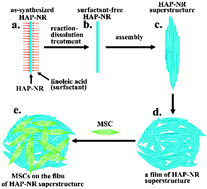“Cleaning” the surface of hydroxyapatite nanorods by a reaction-dissolution approach†
Abstract
Synthetic nanoparticles are always terminated with coating molecules, which are often cytotoxic and not desired in biomedicine. Here we propose a novel reaction-dissolution approach to remove the cytotoxic coating molecules. A two-component solution is added to the nanoparticle solution; one component reacts with the coating molecules to form a salt whereas another is a solvent for dissolving and thus removing the salt. As a proof of concept, this work uses a NaOH–ethanol solution to remove the cytotoxic linoleic acid molecules coated on the hydroxyapatite nanorods (HAP-NRs). The removal of the coating molecules not only significantly improves the biocompatibility of HAP-NRs but also enables their oriented attachment into tightly-bound superstructures, which mimic the organized HAP crystals in bone and enamel and can promote the osteogenic differentiation of mesenchymal stem cells. Our reaction-dissolution approach can be extended to the surface “cleaning” of other nanomaterials.


 Please wait while we load your content...
Please wait while we load your content...